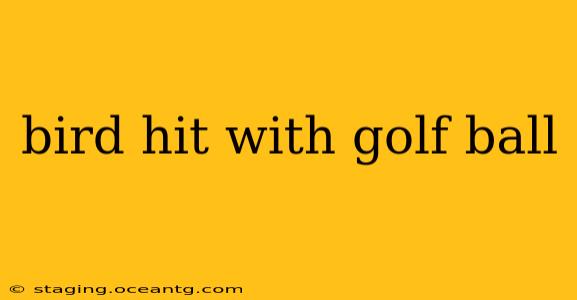It's a distressing sight: a bird struck by a golf ball. While it might seem like a minor incident, the impact can be serious, leading to injury or even death. This guide outlines what to do if you witness such an event, focusing on responsible and humane actions.
What are the Common Injuries a Bird Might Suffer from a Golf Ball Strike?
A golf ball, despite its size, packs considerable force. The injuries a bird might sustain vary depending on the force of the impact and where the bird is hit. Common injuries include:
- Broken bones: Wings, legs, and even skull fractures are possible.
- Internal bleeding: Internal organs can be damaged, leading to internal hemorrhaging.
- Concussion: A direct blow to the head can cause a concussion.
- Soft tissue damage: Bruising and muscle damage are common.
- Shock: The trauma of the impact itself can lead to shock.
What Should I Do If I See a Bird Hit by a Golf Ball?
Your immediate actions are crucial. Here’s a step-by-step guide:
-
Assess the Situation Safely: Approach the injured bird cautiously. Avoid making sudden movements that could frighten it further. Prioritize your safety; if the bird is aggressive or if you feel unsafe, do not approach.
-
Observe the Bird: Check for obvious injuries. Is it bleeding? Can it move its wings and legs? Is it breathing normally? Note its species if possible, as this will help in seeking appropriate assistance.
-
Contact Wildlife Rehabilitation: This is the most important step. Locate a local wildlife rehabilitator or animal rescue organization. Many have 24/7 hotlines. They possess the expertise to provide proper medical care. Providing details about the bird's condition and location will significantly aid their response.
-
Provide Temporary Shelter (If Safe and Necessary): If you must intervene before professional help arrives and the bird is visibly injured and not trying to fly away, you can carefully place it in a well-ventilated cardboard box lined with a soft cloth. Keep it dark, quiet, and warm. Do not attempt to treat the bird yourself. Improper handling can worsen injuries.
-
Do Not Feed or Water the Bird: Well-meaning attempts to feed or water an injured bird can sometimes do more harm than good. Leave that to the professionals.
Is it Always Necessary to Contact a Wildlife Rehabilitator?
While a direct hit might seem serious, some birds may appear injured but recover on their own. However, it’s always best to err on the side of caution. If you have any doubt about the bird's condition, contact a wildlife rehabilitation center. They can assess the situation remotely and advise accordingly.
What if the Bird Flies Away?
If the bird manages to fly away, it doesn't necessarily mean it's unharmed. Monitor its behavior from a safe distance. If it displays unusual behavior – such as difficulty flying, listlessness, or inability to forage – contact a wildlife rehabilitation center.
Can I Prevent Birds From Getting Hit by Golf Balls?
While you can't completely prevent accidents, you can minimize the risk by practicing responsible golfing:
- Awareness: Be mindful of your surroundings and watch out for birds before you swing.
- Reduce Speed: A slower swing reduces the impact force, lessening the severity of potential injuries.
By following these steps, you can make a difference in the life of an injured bird and contribute to responsible wildlife management on the golf course. Remember, swift action and professional help are key to increasing the chances of a positive outcome.
